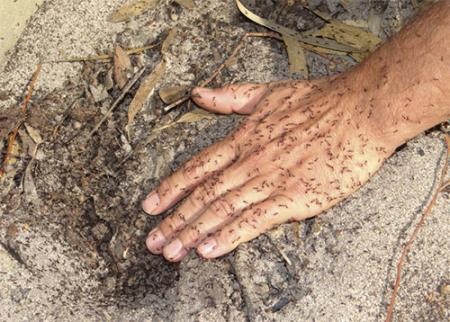Browsing ant (Lepisiota frauenfeldi) is exotic to Australia and is a serious threat to our environment.
Browsing ants do not pose a threat to human health.
Detection in Australia
Browsing ant has been detected in the Northern Territory, Western Australia and Queensland.
Northern Territory
Browsing ant was detected in the Northern Territory (NT) at Darwin’s seaport in June 2015. A total of 24 infested premises have been identified since 2015. The ant has been eradicated from 23 of these locations.
The remaining infected site is at Jabiru, near Kakadu. It was detected in September 2020 and was directly linked to one of the sites in Darwin. The area of the outbreak is 109 hectares.
Queensland
In April 2019 the ant was detected at a shipping container yard at the Port of Brisbane (Fisherman Island). Surveillance activities show the ant has not spread beyond that area.
Western Australia
Browsing ant was detected in Perth, WA in 2019 and 2020. There were 5 infested sites, with 2 in Welshpool and 1 each in Fremantle Port, Bayswater and East Rockingham.
The infestations are mostly associated with sea container handling or landscaping waste facilities.
All these sites have been treated. Monitoring is under way to ensure they remain pest free.
Past detections
Browsing ant has been detected and eradicated several times in WA.
The first detection was at Perth Airport in 2013. In 2014 the ant was detected at commercial properties in Belmont. It was eradicated from both properties. Area freedom was declared in 2016 and 2017 respectively.
In 2017 browsing ant was found at Welshpool and Kewdale in Perth. These detections may be linked to the original Perth Airport infestation in 2013. In 2018, 2 browsing ants were detected at an RAAF Airbase in Bullsbrook.
The Welshpool, Kewdale and Bullsbrook infestations were treated. This was followed by 2 years of multiple surveillance visits. Around 40 hectares were monitored using odour detection dogs. The have been no more detections of browsing ant in these areas.
Response program
Response programs are under way in the Northern Territory, Queensland and Western Australia. This ant is a nationally significant pest under the National Environmental Biosecurity Response Agreement (NEBRA).
Northern Territory
The NT Department of Industry, Tourism and Trade (DITT) leads the response to this outbreak.
A response plan has been approved that covers all aspects of the response including:
- a surveillance and monitoring program
- treatment to eradicate the ant at infected sites
- movement restrictions at high-risk sites and on potential host material
- monitoring after treatment of an infested premises for at least 24 months.
Treatment at sites in Darwin has been completed. Eradication activities are being finalised.
Treatment is under way at a recent infestation at Jabiru NT. Surveillance is ongoing to confirm that it has not spread into surrounding areas.
Aboriginal ranger groups help the NT Government with surveillance at remote sites.
See NT government browsing ant response
Queensland
The Queensland Department of Agriculture and Fisheries (QDAF) leads the response to this outbreak.
The response at Port of Brisbane (Fisherman Island) is progressing. Surveillance activities show that the ant has not spread beyond the area. Treatments at the site were completed in March 2020.
Surveillance is under way across the port since treatment was completed in 2020. Odour detection dogs are involved in the surveillance effort. This will provide confidence that the treatment has been effective.
Businesses that use the port are supporting the surveillance, treatment and eradication efforts.
See Qld government browsing ant response
Western Australia
The WA Department of Primary Industries and Regional Development (DPIRD) leads the response to this outbreak.
A response plan has been approved that aims to eradicate the ant from WA. There are infested sites in Welshpool, Fremantle Port, Bayswater and East Rockingham. It covers all aspects of the response, including:
- a surveillance and trapping program
- treatment to eradicate the ant at industrial, residential and bushland areas.
- movement restrictions at high-risk sites and on potential host material
- monitoring for at least 24 months after treatment to ensure the site remains pest free.
The plan was endorsed through the national emergency response arrangements. Costs are shared between the Australian, state and territory governments. The WA government contributes extra resources and funding to the eradication program.
Surveillance activities continue in metropolitan and regional WA. There have been no further detections of browsing ant.
See WA government browsing ant response
See more
How we coordinate a response to an outbreak.
Your obligations
If you live or work around affected areas in the NT, QLD or WA, look out for this ant. You must report any suspected sightings.
Report sightings
Report any unusual ants, even if you’re not sure.
Call the Exotic Plant Pest Hotline on 1800 084 881 to report signs of browsing ants.
For signs of exotic pests and diseases in imported goods, sea containers or parcels, call See. Secure. Report on 1800 798 636 or use our online form.
Follow the rules
Keep exotic dangerous pests and diseases out of Australia. Never ignore our strict biosecurity rules.
Import shipments may need to be treated and certified. Before you import, check our Biosecurity Import Conditions system (BICON).
Movement restrictions
Movement restrictions are mandated at infested sites. You must adhere to them. They ensure the ant is not moved out of the area or interstate.
Check response activities and restrictions in each state:
About the pest
Browsing ant is an exotic, invasive ant and an environmental pest.
The ant is found in the Mediterranean, Southern Europe, Western Asia and North Africa.
Browsing ants thrive in Mediterranean and tropical climates. This means they’re suited to Australian conditions. These aggressive ants form multi-queened super colonies and monopolise food resources. They can quickly reach large numbers. They put our native species at risk by killing them for food and competing for resources.
What to look for
Browsing ant is a slender ant and is 3-4mm in length. It’s a shiny dark brown colour with long antennae and long legs. It runs about in a haphazard manner when disturbed.
Browsing ant has a range of habitats. It can live on the ground, in leaf litter, trees and infrastructure such as electrical boxes.
How it spreads
Ants can hitchhike on goods and vehicles. They can move with shipping containers and cargo. They can also hide in soil, mulch, fertiliser and plant material.


Impacts
Browsing ant impacts our environment. It forms super colonies and can kill and displace native ants and other insects.
It also protects scale insects which can eventually kill the plants they live on. This means it can potentially impact agriculture and horticulture.
Exotic invasive ants are included on: